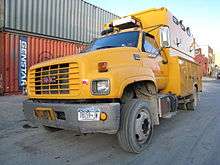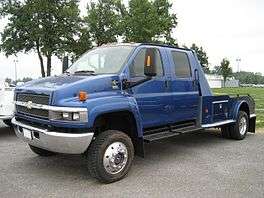Chevrolet Kodiak
| Chevrolet Kodiak/GMC TopKick | |
|---|---|
| Overview | |
| Manufacturer | General Motors |
| Production | 1980–2009 |
| Assembly |
Pontiac, Michigan Toluca, Mexico Montreal, Quebec Bogota, Colombia Tejerías, Venezuela[1] Janesville, Wisconsin São José dos Campos, Brazil (GMC 12-170/14-190/16-220) |
| Body and chassis | |
| Class | Medium Duty Truck |
| Layout | Front engine, rear-wheel drive / four-wheel drive |
The Chevrolet Kodiak (also called GMC TopKick) is a line of medium duty trucks that was marketed and sold by General Motors from 1980 to 2009, when the company exited the medium-duty truck segment.
The Kodiak/TopKick were commonly used as a basis for work trucks, cargo haulers, dump trucks, and similar vehicles which required medium duty torque, GVWR, towing capacity. There are aftermarket coachbuilders that built them as pickup trucks and commercial trucks for consumers.
First generation (1980–1989)
| First generation | |
|---|---|
.jpg) 1980-1989 Chevrolet Kodiak towing mobile police command post | |
| Overview | |
| Production | 1980-1989 |
| Body and chassis | |
| Body style |
2-door truck 4-door truck |
| Powertrain | |
| Engine |
Gasoline Diesel
|
For 1980, General Motors introduced the Chevrolet Kodiak and GMC TopKick as Class 5-7 conventional trucks. Slotted above the medium-duty C/K trucks and slightly below the Chevrolet Bruin/GMC Brigadier, the Kodiak/TopKick combined the updated cab of the C/K with a heavier-duty GVWR and a larger hood, allowing for mid-range diesel engines, up to the Caterpillar 3208 V8. Two-door and four-door cab configurations were available.
Distinguished from the medium duty C/K by its larger hood, the Kodiak/TopKick was given a full-width grille. In place of twin headlights inside the grille, the trucks were given quad rectangular headlights mounted below the grille; the Chevrolet/GMC emblem was moved from inside the grille to the grille. The Kodiak followed the Chevrolet naming tradition of "frontier beast" names for heavy conventionals (Chevrolet Bison and the Chevrolet Bruin) while the TopKick was a military slang term (in line with the GMC Brigadier and GMC General).
Shared with the C/K, the Kodiak/TopKick had two Chevrolet big-block engines for the gasoline engine lineup: a 6.0L V8 and a 7.0L V8. Two diesel engines were available: a Detroit Diesel 8.2L V8 (in turbocharged and naturally-aspirated "Fuel Pincher" form) and a Caterpillar 3208 turbocharged V8.
Second generation (1990–2002)
| Second generation | |
|---|---|
 1990-1994 Chevrolet Kodiak | |
| Overview | |
| Production |
1990–2002 1990-2008 (Mexico) |
| Body and chassis | |
| Body style |
2-door truck 4-door truck |
| Platform | GMT530 |
| Powertrain | |
| Engine |
8.1 liter V8 Big-Block gasoline 7.4 liter Vortec V8 gasoline 7.2 liter I6 diesel Caterpillar 3126B/E 6.6 Caterpillar 3116 |

For 1990, General Motors redesigned the Kodiak/TopKick model lines as part of a redesign that consolidated its multiple large truck lines into a single product line. The GMC General and Astro had already been discontinued by Volvo GM, and General Motors consolidated the Chevrolet Bruin/GMC Brigadier, the medium-duty C/K, and the Kodiak/TopKick lines into the newly introduced 1990 Chevrolet Kodiak/GMC TopKick. Based on the all-new GMT530 architecture, the conventionals adopted their cabs from the GMT400 C/K pickup introduced in 1988. As before, two-door and four-door cab configurations were available; a raised-roof cab was an optional configuration.
Over its thirteen-year production run, the Kodiak/TopKick changed relatively little. In 1995, the Kodiak and TopKick nameplates were dropped, in favor of C4500-C8500 nameplates, bringing the medium-duty trucks in line with the rest of the C/K naming convention. In the mid-1990s, a low-profile "aerodynamic" hood became an option; it was not available in severe-service and school bus configurations. Brazilian versions, badged according to the GVWR in metric tons and a rounded power figure (12-170 for 12-ton GVWR and 170 hp, 14-190 for 14-ton GVWR and 190 hp, and 16-220 for 16-ton GVWR and 220 hp), were assembled from 1995 to late 2001 mostly from imported components and following Mexican specifications, though they were only available with the Caterpillar 3116 engine. While U.S. production of the Kodiak/TopKick ended after 2002, it remained in production for the Mexican domestic market in the GM Toluca, Mexico facility through 2008.
As with its predecessor, the Kodiak/TopKick/medium-duty C used gasoline engines as the standard offering. The 6.0L V8 remained as the base engine until its mid-1990s discontinuation, while the 7.0L V8 was replaced in 1990 by a 7.4L V8; while a larger displacement, the 7.4L engine offered the advantage of fuel injection. In 2002, the 7.4L V8 was replaced by an 8.1L V8, the highest-displacement standard production engine ever built by Chevrolet. In addition to the gasoline engines, GM offered variants of the Caterpillar 3116 and 3126 inline-six diesels throughout the production run of the vehicle.
Third generation (2003–2010)
| Third generation | |
|---|---|
 GMC TopKick C5500 crew cab utility vehicle | |
| Overview | |
| Also called | Isuzu H-Series |
| Production | 2003–2009 |
| Body and chassis | |
| Body style |
2-door truck 4-door truck 2-door cutaway |
| Platform | GMT560 |
| Related |
Chevrolet Express/GMC Savana "Cadillac One" |
| Powertrain | |
| Engine |
6.6 L Duramax V8 diesel V8 7.8 L LG4 diesel I6 8.1 L L18 V8 gasoline |
| Transmission |
5-speed manual 6-speed manual 9-speed manual 10-speed manual 5-speed automatic 6-speed automatic |
For 2003, the General Motors medium-duty range was again redesigned. Due to their nameplate association, the Kodiak and TopKick nameplates were reinstated alongside their various model ranges. Based on the new GMT560 architecture, the Kodiak/TopKick made a major shift in their overall layout. To better compete with the class-leading International DuraStar and Freightliner Business Class M2, General Motors switched from a pickup-based cab to a more vertically-oriented cab based upon the Chevrolet Express/GMC Savana full-size van, allowing for better entry and exit. Although an extended cab was unavailable, a four-door crew-cab was produced with four full doors. Also available as cab and chassis for class 8 truck 8500 series tandem with gvw rating up to 46000lbs
Depending on size range, the Kodiak/TopKick was available with several different engines. On 4500/5500 models, an 8.1L gasoline V8 was standard, with the option of a 6.6L diesel V8. On 6500 models and up, an Isuzu-built 7.8L diesel inline-6 available, in addition to Caterpillar C7. In 2005, factory-installed four-wheel drive was added as an option to Kodiak/TopKick C4500/5500s. These trucks featured solid front axles, instead of independent front suspension featured on the Class 3 3500 Silverado/Sierra. The drive-train consisted of a 6.6L Duramax V8 diesel, Allison 2000 series 5 speed 2003-2006, Allison 2350 series 6speed transmission, and a. Dana s135 2003-2005 Dana S14- 110L rear axle 2005-2009. The 4x4 models added a New Process 273 C Transfer case and a reverse cut Dana 70hd front axle. An optional 9000lb spring and brake package was offered from 2007-2009 for the Dana 70hd as well rear axles could be had in sizes from 11000lb 13500lb,15000lb,19000lb axle options all from Dana. 15k,19k lb options for two wheel drive only. 4x4 came in only 5.13gear ratios
Isuzu H-Series
For 2003, Isuzu marketed a badge-engineered variant of the Kodiak/TopKick named the Isuzu H-Series. Based on the 6500/7500, the Isuzu H-Series was powered by the 7.8L inline-six shared in larger Kodiak/TopKicks and larger Isuzu COE trucks outside North America. Intended largely as a vocational truck, the H-Series was the first conventional sold by Isuzu.
Discontinuation
In December 2007, GM announced its intention to sell its medium-duty truck business, including the Kodiak and TopKick, to Navistar International.[2] In August 2008, both GM and Navistar announced that their memorandum of understanding for the purchase had expired and was not renewed.[3][4]
After four years of working with multiple potential buyers, including an anticipated five-year deal with Isuzu Motors announced late in January 2009 to take over the production line in Flint, Michigan,[5] General Motors decided to wind down its medium-duty truck operations.[6] Production of the Chevy Kodiak and GMC TopKick medium duty trucks in Flint ceased on July 31, 2009. The Montreal plant also closed on July 31, 2009.
Variants
School bus

Following in the tradition of its medium-duty C/K predecessor, the second-generation Kodiak/TopKick was utilized by General Motors to supply the school bus industry throughout its production run. In an unusual move at the time, starting in 1992, GM offered the Kodiak/TopKick solely to a single body manufacturer, Blue Bird Corporation from 1992 to 2002. While the GM chassis was not offered to other manufacturers, Blue Bird offered other available combinations (Ford B700, International 3800, and the later Freightliner FS65) for an additional price. The pairing of manufacturer and chassis supplier would become common through the 1990s in school bus manufacturing, but after 2002, General Motors would become unable to remain a chassis supplier. The Kodiak/TopKick school bus chassis is also notable for being one of the last full-size school bus chassis powered by a gasoline engine.
Pickup conversion

A special Kodiak C4500 was introduced at the 2006 Chicago Auto Show. Aimed at the International RXT (also introduced there), pricing was set at $70,000. The two shared a number of similarities, such as the options included in their premium packages (a powerful audio system and DVD-based navigation system). In comparison, the C4500 had higher power (300 hp versus 230 hp) while the RXT had a higher towing capacity at 16,000 lb (7,300 kg); the C4500 was a 4x4 like the larger International CXT.
A conversion of the commercial GMC TopKick called the Ultimate Class IV TopKick Pickup crew cab pickup truck was developed by General Motors and Monroe Truck Equipment (MTE). This special version features an 8-foot (2.4 m) steel dually pickup box and tailgate with custom composite side panels and protective Rhino interior lining. This vehicle serves as the alternate mode for the character Ironhide in the 2007, 2009 and 2011 Transformers films.
Cadillac One

Entering into service on January 20, 2009, Cadillac One is a common name for the Presidential State Car of United States President Barack Obama. Unlike previous presidential limousines, it is not at all based on a production vehicle, borrowing assemblies from several different vehicles from the 2009 Cadillac line (primarily the Escalade and STS). Although it wears a Cadillac limousine body and badging, the armored vehicle utilizes a four-wheel drive chassis and powertrain of a General Motors medium-duty truck (Chevrolet Kodiak/GMC TopKick).[7] Due to the high-security nature of its use, many details about Cadillac One remain classified.
External links
| Wikimedia Commons has media related to |
References
- ↑ "Archived copy". Archived from the original on 2010-03-23. Retrieved 2010-10-05.
- ↑ "Navistar News".
- ↑ "Navistar News".
- ↑ http://media.gm.com/servlet/GatewayServlet?target=http://image.emerald.gm.com/gmnews/viewpressreldetail.do?domain=5&docid=47990[]
- ↑ http://www.detnews.com/article/20090609/AUTO01/906090330
- ↑ AutoWeek: GM to halt medium-duty truck production
- ↑ Merksamer, Gregg D. (6 November 2008). "Cadillac testing new Obama limo" – via The Boston Globe.